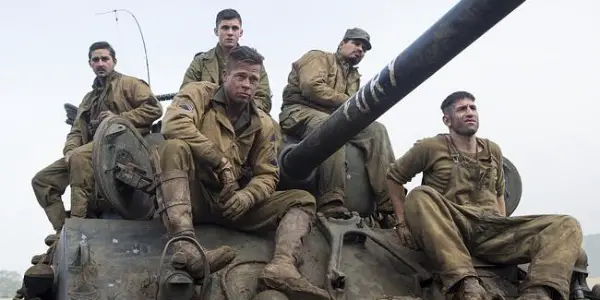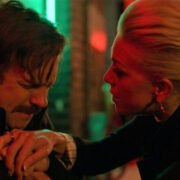FURY: Great Action and Tropes Galore

Jay is just a dude who takes in an unhealthy…
David Ayer’s Fury is the story of an American tank unit led by “Wardaddy” (Brad Pitt) near the end of the European Theatre in World War II. Ayer is still best known for writing 2001’s Training Day, but after he made the surprisingly acclaimed End of Watch, he has been given the chance to direct a full-blown war film. Ayer‘s hyper-masculine style is one that could be to the detriment of a war film that is trying to stay grounded in reality, but he is able to dial back his tendencies enough to keep it from being a glorification of violence. The violence is there in spades, but this is the make-you-wince-and-suck-your-teeth type of violence, not the stand-up-and-cheer-for-Liam–Neeson type of violence.
Every now and then (maybe once per year) you will watch a film and have to sit and decompress for a minute or so when the credits begin to roll. The most recent film I can remember doing this in was 12 Years a Slave. I was emotionally drained from the experience of that film, and Fury left me feeling about the same way. The problem is, I didn’t learn anything from Fury like I did from 12 Years. As much as Fury wants to be one, it is not an important movie. The battle scenes are something to behold, but the script as a whole is generic and it feels like we have seen all of these characters (minus, perhaps, “Wardaddy”) a hundred times before. The true feel-bad film of the year packs a whole lot of style but, as seems to be David Ayer’s M.O., it lacks substance.
Tanks in Action
Let’s start out with what really, really works in Fury. It is a very nice change of scenery to have the film focus on the crew of a Sherman Tank instead of the traditional World War II films that revolve around infantry units or airmen. And the scenes that take place in the tank are sheer claustrophobic goodness. My first takeaway from the film was how brutal life in that tank would be. Five men shoved inside an enclosed box no bigger than a kitchenette.

No doubt about it, Fury definitely captures the “war is hell” element in spades. And the tanks used in the film are actually of the World War II era, which was a tremendous touch. Authenticity is a rarity in a world where most action movies are heavy on the green screen. The most awe-inspiring scene in the film, involving a behemoth German Tiger tank, features the only working Tiger in the world. This massive beast of a machine appears out of the blue and is every bit as menacing as any villain I have seen this year.
The slow-moving tanks make for incredibly nerve-racking skirmishes. The scale of the battles is very interesting and, again, adds to the authenticity of the film. We all know about the storming of Normandy beach and we have seen what that looks like in Saving Private Ryan, but a battle like that was the exception, not the rule. This film takes place in April of 1945, just weeks before Nazi Germany would surrender, effectively ending the war in Europe. The Allied forces were pushing towards Berlin one checkpoint at a time in small units.
The tasks the crew of “Fury” is asked to achieve are very small in the scheme of things, but they inevitably run into enemy units traveling from place to place. The battles are interesting because they feature so many types of weapons; there are tanks, machine guns, heavy artillery, sniper rifles, and more. It makes for a series of wonderful scenes that are well choreographed and make good use of effects (both special and practical). The most impressive visual element of the film, and one I cannot remember having seen before, is the effect of the massive cannon rounds deflecting off of the tanks’ steel frames and shooting off into the distance. It all happens so fast but gives you a sense of how powerful these machines are. If only the script was as effective as the action…
Haven’t I seen you before?
The fresh-faced, innocent new kid. The brash, insensitive Southern guy. The funny minority. The religious one. The battle-tested wise one. These are called tropes, kids, and these are the characters that Fury has to offer. Each character has a few great moments, but they cannot overcome their generic DNA. The performances from Brad Pitt, Shia Labeouf, Michael Peña, and Jon Bernthal (who is sneakily becoming one of the most reliably great actors around) are actually quite strong considering the material they have to work with, but they are only barely able to keep the ship (or tank) afloat with Logan Lerman’s Norman dragging them all down.

Norman is the bright-eyed new kid sent from his job as a typist to man “Fury’s” machine gun. Norman is the character that the story revolves around. But more than anything, Norman is a cardboard cutout of a character who I could never convince myself to root for. Lerman, apparently a graduate of the Sam Worthington School for the Bland, is force-fed to you. There is no way to overlook his whiny, entitled, clueless character.
Besides the character creation, there are a few scenes that are too ambitious for a writer/director of Ayer’s caliber to pull off. I speak mostly of a scene in the middle of the film after Pitt and Co. have captured an SS-controlled village. Pitt’s “Wardaddy”, along with Norman, enters a woman’s apartment one story above the town square to make sure there is no threat. The next few minutes are a great example of how to build tension, as there is a will-he-won’t-he feeling to”Wardaddy’s” actions towards the woman. Pitt really shows his chops here and this was the only time I can remember not knowing what was coming next. But this great tension is washed away when the rest of the crew drunkenly bust through the door.
What transpires after that is a poor version of a Quentin Tarantino dinner scene (the comparisons between Fury and Inglorious Bastards are inevitable since they both feature Pitt in World War II leader-mode; even though they couldn’t be more different tonally). I can’t tell you the exact time we spend in this little apartment, but it felt like 20+ minutes, and there was not enough to learn in the scene to justify this length. And it is here that we see the tropes at their trope-iest. There is nothing surprising about what transpires. The good ole’ boy (Bernthal) is crass and abrasive (and insinuates that rape is not something he is morally opposed to), the minority (Peña) provides levity, and the Christian (Labeouf) tries his best to understand a situation he does not agree with. It’s all very derivative and I was begging for another battle sequence.
A Grand Finale
About 20 minutes into Fury I could have told you who was going to live and who was going to die. I could have told you that an SS soldier would, at some point, show some degree of mercy (which, to me, seems absurd – these are not your run-of-the-mill Nazis; these are the fanatics fighting a battle they know they are going to lose in the name of their insane leader). But sometimes, it’s not about the destination, it’s about the journey. And even though I knew exactly what would happen before the final confrontation began, it was so well-made and gripping that I enjoyed it nonetheless.

With limbs and projectiles of all varieties shooting off in every direction, the action is relentless for the last 20 or so minutes. It is 300 in a tank, without the painted-on abs. This scene, like others, does a tremendous job of making the small-scale feel massive. Because here it is not 300 vs. 1 million, it is merely 5 vs. 300. And yet, the battle feels no less epic than those in the mega-budget blockbusters.
It should be noted that this is the most purely violent film I have seen this year. It is not for the faint of heart. The first time we meet Norman, he scrapes half of a face out of the tank; dead soldiers are nonchalantly run over by the tank; children killed by Nazis are hanged for display. No one will leave the theater thinking of this film as a glorification of war. Instead, you will feel as though there were no winners at all. It is not a unique message, but what war movies really have one?
The nature of war is universal, unflinching. From Paths of Glory to The Hurt Locker, war films show the struggles of all sides: winners, losers, and non-participants. And while Fury is not the high-caliber, meaningful film that those previously mentioned are, it is still a well-made war movie despite its paper-thin characters and a predictable story. Come for Brad Pitt’s haircut, stay for the Tiger tank, and take Fury for what it is.
What did you think of Fury? Did you find it too dark? Did you like the characters? Let us know below!
Does content like this matter to you?
Become a Member and support film journalism. Unlock access to all of Film Inquiry`s great articles. Join a community of like-minded readers who are passionate about cinema - get access to our private members Network, give back to independent filmmakers, and more.
Jay is just a dude who takes in an unhealthy amount of media of all types. Currently living in Atlanta, Georgia, he firmly believes that all movie theaters should have leather recliners, you eat popcorn too loudly, and if you don't put that cellphone away in 2 seconds you will learn the definition of frontier justice.











